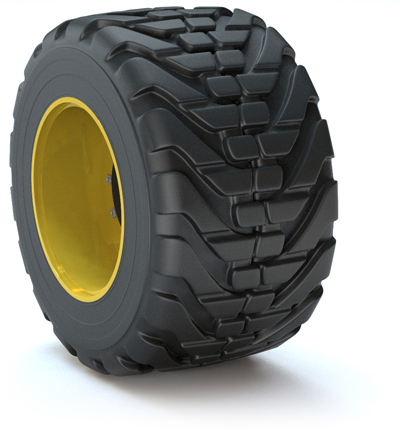CLARK TRACKS tracks tyre selection
What you should know when you choose tyres and tracks

Combination of tyre and track
Through extensive research and development, CLARK TRACKS tracks has engineered tracks that have both tire-preserving properties and minimal tire slip in the track.
Each pad has an internal hook that hooks onto the tire surface to provide power transmission between the tire and the track. Moisture can affect the effectiveness of this hook – for example when used on wet peat or clay soil or if it is affected by age-related wear, it can cause a slip between the caterpillar and the tire.
Tire slippage can also be a problem with powerful machines used under heavy loads or on steep, wet ground. If the hook in the band is too sharp or aggressive, the tire is damaged, the hook becomes too flat and slippage increases. Narrow skates are less likely to lose grip, unlike flat, wide skates. Do not weld additional power transmission hooks into the tracks. The best insurance against slippage and wear is to install the ideal tracks for your tires right from the start.
As a rule, the strips on each side at a distance of 5 to 10 mm between the sidewall of the tire and the shoe. (The bandwidth ranges from 2 to 20 mm and depends on the construction of the track and the condition of the tire.)
Tire-caterpillar compatibility
Please only use suitable tires with tracks:
- Tires must be designed for use with track.
- The tires must have a large number of steel layers and reinforcements, as well as a diagonal construction.
- Tires must be made of an abrasion-resistant rubber compound that can be used with adhesive tapes.
- Tires should be used with reinforced forestry rims.
- The tires must have the recommended hose so that the tires can be filled evenly and the correct load capacity is achieved.
- Tires must be filled to the correct operating pressure for use with belts. If the manufacturer does not give specific recommendations on tire pressure when using ligaments, these should be filled to the maximum recommended tire pressure.
Tires load capacity
Many tires can be equipped with tapes. However, there are more or less suitable tires.
- Manufacturers of high quality forest tires such as Nokian and Trelleborg consider the use of tire design tapes.
- The most important factor is the correct atmospheric pressure. Please refer to the table. If there is no information on the correct air pressure with straps for your tire, inflate the tires to the maximum inflation pressure.
- The ideal tire has a round shoulder z. B. Nokian Forest King F2, Trelleborg T480 and cross-sections that fit with the nose in the strip
- The tires should have steel reinforcements and a high number of layers. In particular, when driving with broadening bands, a high quality tire must be used
- Radial tires are not recommended, with the exception of the Nokian Forest Rider
- Bogie belts cannot be mounted on machines with independent wheel suspension (eg dump trucks or trucks).
Tire pressure
You can find more information about Nokian and Trelleborg tires and their compatibility with our products in the tire recommendations that you can download from our website.
Tyre profile
Some tire profiles are particularly well suited to tracks like Nokian Forest King F2 and Trelleborg T480. Tires with “top groove pattern” such as Nokia TRS2 and Trelleborg T440 are not ideal. The edges of the cliff can get clear marks over time. Basically, only tires with a steel belt and a large number of layers should be used.




